Asociación entre los estilos de aprendizaje y ansiedad en estudiantes de medicina humana

Ver/
Descargar
(application/pdf: 706.8Kb)
(application/pdf: 706.8Kb)
Fecha
2019Autor(es)
Talledo Vallejo, Marco Adolfo
Metadatos
Mostrar el registro completo del ítemResumen
Objetivo: Determinar qué estilo de aprendizaje es más susceptible a presentar
ansiedad.
Material y Métodos: Es un estudio observacional, transversal y analítico. La
población de estudio estuvo constituida alumnos de Medicina Humana en el Campus
Trujillo de la Universidad Privada Antenor Orrego que cursan el semestre 2018-2, El
total de estudiantes matriculados fue de 2813 alumnos, de los cuales se logró
encuestar a un total de 531 estudiantes, excluyéndose 97, dicha muestra represento
un nivel de confianza superior al 97% correspondiente al cálculo de muestra para
encuesta poblacional según el software EpiInfo®. Se utilizaron 3 cuestionarios
validados con un valor α de 0.73, un cuestionario de datos generales, el inventario de
estilos de aprendizaje de Kolb V3.1 y el Inventario de desorden de ansiedad
generalizada (GAD-7), se utilizó estadística descriptiva, pruebas de Chi-cuadrado y T
de Student.
Resultados: Se encontró asociación significativa entre los estilos de aprendizaje y
ansiedad clínica(p = 0,007), los estilos más predispuestos a la ansiedad clínica fueron
el “Divergente” (47,76%) y “Asimilador” (30,35%), se encontró además que el estilo
“Convergente” (8,46%), es posiblemente protector frente a la ansiedad clínica(p =
0,036). Otras variables asociadas significativamente a la ansiedad clínica fueron el
consumo de tranquilizantes automedicados(p=0,004; OR=20,04) y el sexo
femenino(p=0,022; OR=1,63).
Conclusiones: Existe asociación significativa entre los estilos de aprendizaje y la
ansiedad a nivel clínica(p=0,007), teniendo como estilos de aprendizaje más
asociados: “Divergente”(47,76% ) y “Asimilador”(30,35%) . Se considera al estilo de
aprendizaje “Convergente” como un factor protector en cuanto a la presencia de
ansiedad clínica y se consideran factores predisponentes al sexo femenino y al
consumo de tranquilizantes automedicados. Objective: Determine what type of student according to their learning style is more
susceptible to present anxiety.
Material and Methods: It is an observational, transversal and analytical study. The
study population consisted of students of Human Medicine at the Trujillo Campus of
the Universidad Privada Antenor Orrego from the period 2018-2, The total number of
students enrolled was 2813 students, which would survey a total of 531 students,
excluding 97, said sample represented a confidence level higher than 97% i n the
calculation of the population sample according to the EpiInfo® software. We used 3
validated questionnaires with an α value of 0.73, a general data questionnaire, the Kolb
V3.1 learning styles inventory and the Generalized Anxiety Disorder Inventory (GAD7),
a descriptive statistical analysis was made with Chi square tests and Student's T test. Results: A significant association was found between the learning styles and clinical anxiety (p = 0.007), the styles most predisposed to clinical anxiety were the ““Divergent““ (47.76%) and ““Assimilator““ (30.35%). Also was found that the ““Convergent““ style (8.46%) is possibly protective against clinical anxiety (p = 0.036). Other variables
significantly associated with clinical anxiety were the consumption of self-administered
tranquilizers (p = 0.004, OR = 20.04) and the female sex (p = 0.022, OR = 1.63).
Conclusions: There is a significant relationship between learning styles and anxiety
at the clinical level (p = 0.007), having as more associated learning styles: ““Divergent““
(47.76%) and ““Assimilator““ (30.35%). Consider the ““Convergent““ learning style as a
protective factor in the presence of clinical anxiety and predisposing factors were the
female sex and the consumption of self-administered tranquilizers.
Palabras clave
Colecciones
- Medicina Humana [3044]

